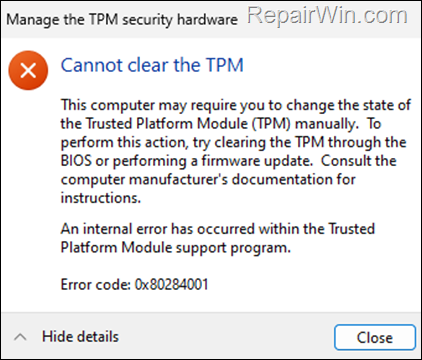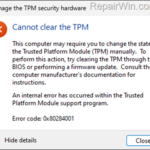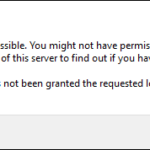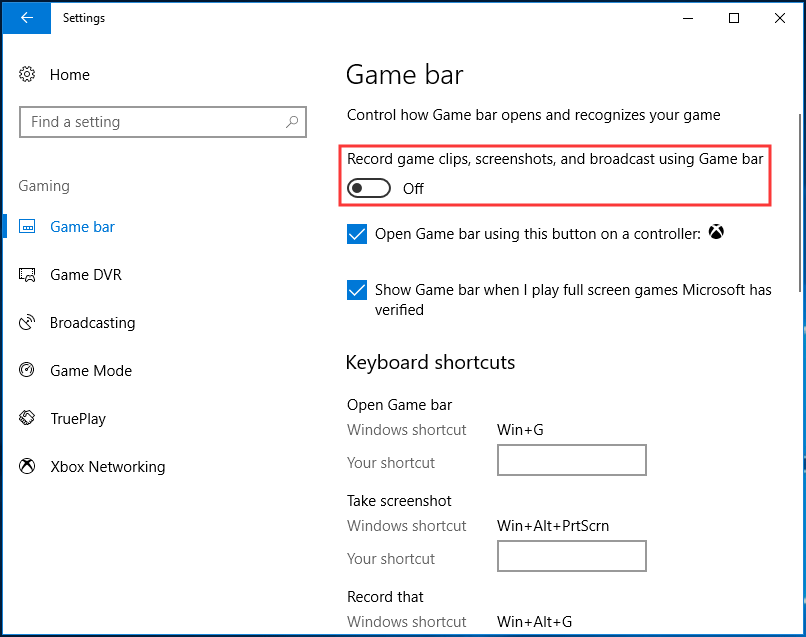.single .post-author, .post-date {
text-transform: none;
}
,
Last updated: April 11th, 2024
If you cannot clear the TPM on Windows 10/11 with error code 0x80284001, 0x80290300 or 0x80290304, continue reading below to fix the problem.
Problem in details: When trying to clear the keys on the TPM module from the TPM management console (tpm.msc), you receive one of the following errors:
Cannot clear the TPM.
The computer may require you to change the state of the Trusted Platform Module (TPM) manually. To perform this action, try clearing the TPM through the BIOS or performing a firmware update. An internal error has occurred within the Trusted Platform Module support program.
Error code: 0x80284001


Cannot clear the TPM.
The TPM may not be in the correct state to perform this action. Try refreshing the TPM Management console screen to see whether the action is still available.
A general error was detected when attempting to acquire the BIOS’s response to a Physical Presence command. Error Code 0x80290300 (or 0x80290304)
How to FIX: Unable to Clean TPM with error 0x80284001, 0x80290300 or 0x80290304 on Windows 10/11.
Step 1. Allow TPM Management from the Operating System in BIOS.
On some computers, there is a setting in the BIOS that prevents the Operating System from managing/resetting the TPM keys. So…
1. Shutdown your computer.
2. Power On your computer again and when you see the manufacture’s logo press the corresponding key (eg: Del, F2, F10, etc.) to enter in BIOS Setup Utility.
3. Navigate to Security settings and look if there is a setting named RESET of TPM from OS or OS Management of TPM. If so, Enable that setting to allow the operating system to manage the TPM Module. *
* Note: If you don’t find that setting, skip to next step.
4. Boot to Windows and try to reset the TPM again. If you receive the same error (Cannot Clean the TPM), proceed to next step.
Step 2. Clear the TPM from BIOS.
If you cannot reset the TPM keys from within Windows, follow these steps and reset the TPM keys from BIOS.
1. Boot to Windows and disable the device encryption (aka “BitLocker encryption”) if enabled.*
2. Then for precaution reasons, backup your data to an external USB drive to avoid data loss.*
3. Specify a password for your account in Sign-in options: If you sign in to Windows using a PIN, then after deleting the TPM keys Windows will lose your PIN information and as a result you may not be able to sign in to your computer using you PIN. To avoid this to happen, go to Start > Settings > Accounts > Sign-in options, click Password and then Add to specify a password for your account. *
* Related article: How to Reset or Clear TPM without Losing Data.
4. After following the above steps, shutdown your computer.
5. Power On your computer again and when you see the manufacture’s logo press the corresponding key (eg: Del, F2, F10, etc.) to enter in BIOS Setup Utility.
6. In BIOS setup, find the Secure Boot option and make sure that is Enabled. (If not, Enable it).
7. Then navigate to Security settings page and ensure that a TPM Device is Available and the TPM State is Enabled. (If not, set the TPM State to “Enabled”, Save and Exit from BIOS, boot to Windows and try to clean the TPM through the TPM Management console (tpm.msc).
8. To clear the TPM keys from BIOS, do one of the following:
- Select the Clear TPM option and press Enter and then Yes to reset the TPM to its default settings, or…
- Select the Restore Security settings to Factory Defaults option and press Enter.
![image_thumb[16] image_thumb[16]](https://qnet88.com/wp-content/uploads/2024/04/image_thumb16_thumb.jpg)
![image_thumb[16] image_thumb[16]](https://qnet88.com/wp-content/uploads/2024/04/image_thumb16_thumb.jpg)
6. After resetting the TPM, Save and Exit from BIOS setup.
7. After the computer restarts, you may be asked to accept the change by pressing a corresponding on your keyboard. If so, press that key, to reset the TPM and to clear all its security keys.
8. Now, let your computer to boot to Windows, sign-in with the account password and change the PIN when asked.
9. Finally, re-enable the device encryption and you’re done!
Additional troubleshooting steps.
If after following the above steps, you still cannot clear the TPM, try the following:
- Enter in BIOS setup and Disable the TPM. Then Save and Exit from BIOS settings. Then, without booting to Windows, re-open BIOS settings and re-Enable the TPM. Save and exit again and let your system to boot to Windows and try to clean the TPM again.
- Visit the manufacturer’s support website to download and install the latest Firmware/BIOS update for your device.
That’s all folks! Did it work for you?
Please leave a comment in the comment section below or even better: like and share this blog post in the social networks to help spread the word about this.

- Author
- Recent Posts
- FIX: Cannot clear TPM – 0x80284001, 0x80290300 or 0x80290304. – April 11, 2024
- Unable to Schedule Teams Meeting in 15 or 10 minutes slots (Solved) – April 9, 2024
- How to Share Folder without Username/Password on Windows 10/11. – April 4, 2024



